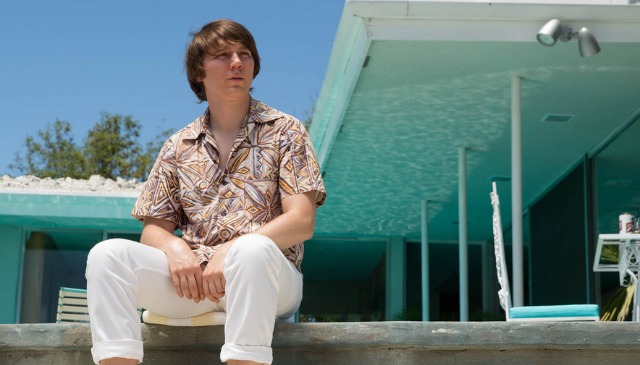Two Sides Of Brian Wilson Showcased In Uneven But Affecting 'Love & Mercy'
By Joel Wicklund in Arts & Entertainment on Jun 4, 2015 2:35PM

Paul Dano as Brian Wilson in “Love & Mercy.” (Photo: Francois Duhamel/Roadside Attractions)
The Beach Boys are a band with a divided legacy. They are widely remembered as a kind of wholesome group that always sang about fun in the California sun—a reputation cemented by decades of touring as a nostalgic oldies act. But they are also revered for their increasingly sophisticated recordings of the mid-to-late '60s under the creative control of Brian Wilson. Many consider those highly orchestrated, often experimental records to be right up there with the Beatles' best work.
So maybe it's fitting that Love & Mercy, a biographical portrait of Wilson split between two eras, is a film that at times seems quite bold and at others extremely conventional. On balance, the movie works, even as its better moments suggest a more satisfying whole than what it delivers in the end.
The movie is at its best during scenes set during the 1960s, with Paul Dano playing Wilson in his 20s, reaching his creative peak just as a psychological breakdown starts to take its toll. Dano has Wilson's cadence and awkward mannerisms down and with his hair styled for the period and looking slightly doughier than usual, he manages to look a little like him too. He effectively conveys Wilson as a damaged innocent: joyful making his music but unable to confront the abusiveness of his father or handle the drug intake that becomes an escalating part of his life. When he begins to hear voices in his head, he crawls further into his own isolation.
Those scenes alternate with scenes starring John Cusack as the forty-something Wilson in the 1980s, when his entire life was under the Svengali-like control of therapist Eugene Landy (Paul Giamatti). When Wilson meets and falls for pretty car saleswoman Melinda Ledbetter (Elizabeth Banks), she quickly recognizes his extreme vulnerability and Landy's bullying exploitation. Ledbetter fights to free Wilson from his mental and chemical dependence on his overseer.
In contrast to Dano's studied incarnation of the younger Wilson, Cusack's performance seems focused solely on the older version's emotional fragility and clouded mindset, which he captures very well. However, there is something jarring about going back and forth from Dano's dead-on embodiment of the character to Cusack's much looser representation. He didn't even lighten his dark hair much for the role or style it the way Wilson wore his in the '80s. At a recent appearance at the Music Box Theatre, Cusack said the differences in his appearance and Dano's were intended to emphasize they were not trying to give a single, definitive portrayal of their subject.
In that way, the aim may have been to mirror I'm Not There (2007), director Todd Haynes' fascinating, fictionalized portrait of Bob Dylan, in which six different actors (including, most famously, Cate Blanchett) played Dylan-like or Dylan-inspired characters. Oren Moverman, who co-wrote that film with Haynes, is also one of the screenwriters of Love & Mercy. But where I'm Not There was a truly experimental narrative, Love & Mercy ties its two periods together very neatly and the Cusack section in particular follows very traditional film biography plotting.
That includes two overly familiar Hollywood storytelling crutches: the hissable villain (Giamatti's Landy) and the essentially flawless love interest (Banks' Ledbetter) who arrives to save the troubled hero. Both Giamatti and Banks give very good performances but their roles are really thin. We see almost nothing but heroic compassion from Ledbetter and we don't even get a glimpse of the persuasiveness Landy must have had initially to immerse himself so fully in the musician's life.
If nothing else, the discredited late therapist brought Wilson back from extreme, morbid obesity and there were surely other superficially positive changes that made his control possible before his unhealthy methods became obvious. But in Love & Mercy, all we see is the nefarious side, leaving one to wonder how even a psychologically crippled Wilson could not see through his act. Of course, not even an epic-length film could cover Landy's years of manipulations in detail, but a small sample of them would have fleshed out the character to better effect.
Still, the performances carry the film's later era through its clichés and the Dano section of the story offers even greater compensations. Not only are the characterizations fuller (even Wilson's longtime adversarial bandmate Mike Love, well played by Jake Abel, gets one scene where he lets his abrasiveness mellow), but director Bill Pohlad brings much richer visual expressiveness to the earlier years. Particularly striking is a shot where the camera turns a slow, full 360 degrees around a recording studio as Wilson works passionately with studio musicians, while Love and other Beach Boys sit mainly inactive and bored...reduced to standbys in the creative process.
Pohlad also brings some compelling imagery and editing strategies to convey Wilson's mental meltdown. After more than a decade of impressive credits as a producer (Brokeback Mountain, Into the Wild, The Runaways, 12 Years a Slave), this marks just his second directorial effort and his first since 1990. The uneven quality of Love & Mercy suggests he needed to knock the rust off a bit, but there's enough worthwhile in the film to mark his return to the job as a success. Like Brian Wilson, this movie takes a rocky road but survives the journey mostly intact.
Love & Mercy. Directed by Bill Pohlad. Written by Oren Moverman and Michael Alan Lerner. Starring John Cusack, Paul Dano, Elizabeth Banks and Paul Giamatti. 120 mins. Rated PG-13.
Opens Friday, June 5 at multiple city and suburban theaters.